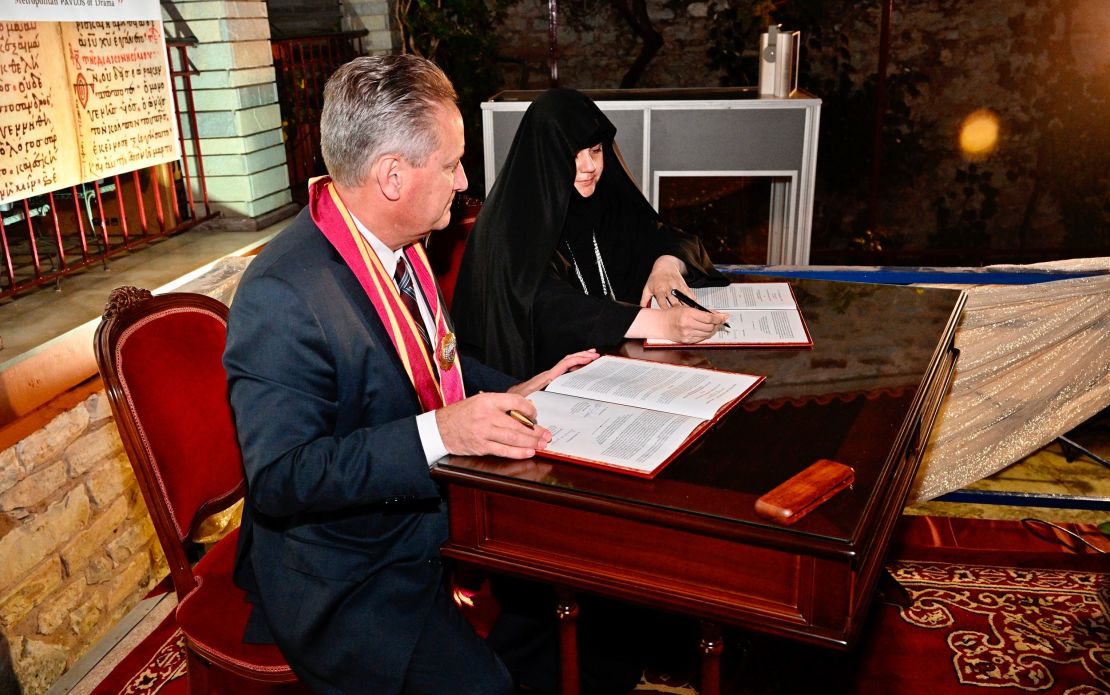A 1,000-year-old manuscript looted during World War I has been returned to the Greek monastery from where it was stolen more than a century ago.
The manuscript is one of the oldest handwritten gospels in the world, according to a news release from the Museum of the Bible, which acquired it in 2014.
The document was written in a Greek monastery in southern Italy during the late 10th to early 11th centuries, says the Museum of the Bible. But sometime between the 14th and 15th centuries, it moved to the Kosinitza Monastery, also known as the Theotokos Eikosiphoinissa Monastery, in northern Greece.
When the Bulgarian Army invaded Greece during World War I, soldiers looted the monastery, stealing over 400 precious manuscripts as well as other books, objects, and cash. Some of the manuscripts were sold in Europe – and eventually ended up in American museums.
The Eikosiphoinissa Manuscript 220 was sold by Christie’s in 2011, says the museum, and then purchased by the Green Collection of Oklahoma City, which donated it to the Museum of the Bible.
In 2015, the Greek Orthodox Church had asked several American institutions that held manuscripts from Kosinitza to voluntarily return them to the monastery. The museum started researching its Greek New Testament manuscripts in 2019, leading scholars to realize the document had been stolen from the Kosinitza Monastery. And in 2020 the museum reached out to Eastern Orthodox leaders to express its desire to return the manuscript.
The manuscript was finally returned to the monastery in a formal ceremony on Thursday, says a joint statement from the Greek Orthodox Archdiocese of America and the Museum of the Bible.

“When the Museum of the Bible discovered that this text was illegally and rapaciously taken from the Monastery, it moved quickly, responsibly and professionally to see to its restoration and repatriation,” said Archbishop Elpidophoros of America, who represented His All-Holiness Ecumenical Patriarch Bartholomew during the return ceremony, according to the statement.
“We cannot express enough our gratitude to the Green Family and the Museum for their Christian and professional service,” he said. “You have set an example for others to follow, and we pray that they do.”
Ecumenical Patriarch Bartholomew, the leader of the Eastern Orthodox church, loaned three other manuscripts to the Museum of the Bible as a “gesture of gratitude for the gospel manuscript’s return,” says the statement.
George Tsougarakis, general counsel at the Greek Orthodox Archdiocese of America, told CNN that he hopes the return prompts other institutions to return manuscripts stolen during the Bulgarian invasion.
Repatriation is “recognition of the inequities and the injustice that these areas went through back then, which led to the removal of these priceless artifacts,” he said. “And it’s a way of, sort of making the world right again.”
He noted that copies of the manuscript can allow academics to continue to study it from afar. But for the monks who venerate the manuscript, the physical document represents a powerful connection to the monks who came before them and to the religious tradition itself.
“There is something to say about touch,” Tsougarakis said. The ability for the monks to say, “‘I touched the page that my predecessor touched’ – it means something, it’s a community.”
And the Museum of the Bible has set a compelling example for other institutions that have manuscripts stolen from Kosinitza, he added.
“We urge them to do the right thing,” he said. “There’s only one right answer here. And we hope that they follow suit.”




